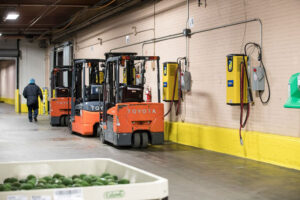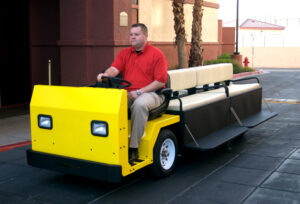Archive for August, 2023
What You Need To Know About Forklift Tires
In industrial settings and warehouse operations, forklift tires play a pivotal role. Beyond supporting loads and providing traction, forklift tires affect efficiency, safety, and the machine’s lifespan. This blog will explore the types of forklift tires available, the scenarios in which each type excels, and the consequences of neglecting forklift tire maintenance.
Types of Forklift Tires
Pneumatic Tires are filled with compressed air.
- Advantages: Pneumatic tires provide a smooth ride over rough terrains, excellent shock absorption, and enhanced traction and stability due to their larger surface area.
- Applications: Pneumatic tires are ideal for indoor and outdoor applications like construction sites, lumberyards, and shipping docks with uneven terrain.
Solid Rubber Tires contain solid rubber components.
- Advantages: Solid rubber tires are virtually puncture-proof, reducing the risk of downtime due to flats.
- Applications: These tires are great in manufacturing, warehousing, and distribution centers, where the forklifts predominantly operate indoors on smooth surfaces.
Cushion Tires, often called press-on tires, are solid rubber and have a metal band inside.
- Advantages: Cushion tires are compact and highly maneuverable, with a lower profile for increased visibility.
- Applications: Cushion tires are great in indoor environments such as warehouses, retail spaces, and manufacturing facilities.
Polyurethane Tires are lightweight tires made from plastic and rubber.
- Advantages: Polyurethane tires are non-marking, provide excellent traction on smooth surfaces, and resist cuts and tears.
- Applications: Polyurethane Tires are perfect in indoor environments such as food and beverage industries, electronics manufacturing, pharmaceutical facilities, and other applications where minimizing floor damage and noise is a priority.
Non-Marking Tires contain a combination of rubber and other materials that leave minimal marks on the floor surfaces.
- Advantages: Non-marking tires prevent scuffing and marking on floors, making them suitable for environments where appearance matters.
- Applications: Non-marking tires are often found in retail stores, exhibition halls, and cleanroom facilities.
Forklift Tire Maintenance
The consequences of neglecting forklift tire maintenance go beyond just the tires themselves. Old, worn, or damaged tires can affect your forklift’s performance in several ways.
- Fork Wear: Worn or damaged tires can lead to the dragging of forks while traveling.
- Undercarriage Damage: Lowered ground clearance due to damaged tires can expose the forklift’s undercarriage to debris.
- Reduced Lift Height: Worn or damaged tires can reduce the forklift’s lift height, causing potential product loss.
- Electrical Issues and Safety Hazards: Vibration or bouncing caused by tires in poor condition can lead to loosened bolts, connectors, and other components, including electrical connections, potentially causing electrical failure or other severe safety hazards.
The correct tires, regular inspections, and timely maintenance can help protect your forklift for years to come. If your forklift or fleet needs tires or maintenance, contact us today! We carry replacement forklift tires for almost any application and forklift parts for most makes and models.
Act now and save 15% on tires, seats, forks, and steel tanks during our Summer Savings Event.
How To Get More From Your Equipment Provider
Material handling solutions are more than renting, selling, and servicing forklifts. Our full range of services can optimize your operations, enhance efficiency, and boost your bottom line. Here are eight ways we can elevate your business beyond the realm of forklifts.
1. Guidance from Energy Solutions Consultants 
The rapid influx of advanced technologies into the market undoubtedly benefits the industry. However, the plethora of choices can often make it challenging to discern the optimal solution for your needs. To help you navigate energy information overload, we offer on-site consultations, environmental insights, knowledge about alternative energy sources, guidance on chargers and accessories, and comprehensive service and repair support.
2. Warehouse Efficiency: Complimentary Analysis
Unlock the full potential of your warehouse space with our complimentary warehouse and pallet position analysis. Our seasoned Storage and Automated Systems professionals will meticulously evaluate your warehouse, providing innovative solutions to maximize pallet storage, boost productivity, and drive your bottom line to new heights. To glimpse our transformative analysis, check out two compelling examples here.
3. Expert Pallet Racking Solutions
Efficiency is the cornerstone of success. Our experts stand ready to perform a complimentary pallet storage analysis, guiding you through the re-design, procuring, and installing cutting-edge pallet racking and storage systems. Witness the evolution of your storage infrastructure as we streamline your processes for optimal efficiency.
4. Advance by Nilfisk and Kärcher Industrial Scrubbers and Sweepers
Maintain pristine and sanitized facilities with Advance by Nilfisk and Kärcher industrial scrubbers and sweepers. As a proud dealer of Advance by Nilfisk and Kärcher, leaders in resource-conserving cleaning systems, we offer high-performance solutions renowned for their innovation and quality. Elevate the cleanliness of your workspace to match the excellence of your operations.
5. Columbia Electric Utility Vehicles
Navigate your workspace with newfound agility using Columbia electric utility vehicles. With a diverse lineup catering to private, commercial, and industrial use, Columbia’s electric utility vehicles deliver versatility, power, and efficiency.
6. Elevate Your Reach with Aerial Platforms and Boom Lifts
Our selection of Noblelift scissor lifts and JLG aerial platforms, and boom lifts offer the ideal solution for those seeking incredible heights. Whether scissor lifts, telehandlers, vertical mast lifts, or boom lifts, our inventory blends strength, versatility, and intelligent technology. Choose between buying or renting, and experience quality equipment that takes your projects to the next level.
7. OSHA-Compliant Forklift Operator Training
Safety is paramount. Ensure OSHA compliance by enrolling your forklift operators in our comprehensive training program. We offer English and Spanish courses at our Santa Fe Springs location or at your facility to keep your operators and pedestrians safe. Explore common questions and insights about forklift safety training here.
8. Tailored Warehouse Design for Your Unique Needs
Redefine your warehouse storage and distribution system with the guidance of our seasoned material handling experts. Adept at designing systems that align with your unique requirements, our team ensures your operations run seamlessly, maximizing efficiency and optimizing space utilization.
Our services’ core lies in an unwavering commitment to innovation, efficiency, and safety. Beyond the scope of forklifts, we offer comprehensive material handling solutions that cater to your needs and empower your business to thrive. Contact us today to learn how we can revolutionize your operations and warehouse space.
How To Make a Forklift Maintenance Schedule
Forklifts, like any piece of machinery, require proper care and maintenance. A well-structured forklift maintenance schedule is the cornerstone of keeping these powerful machines running smoothly and preventing unexpected breakdowns that can disrupt workflow and result in costly repairs. This comprehensive guide will walk you through ten essential steps to create an effective forklift maintenance schedule.
Why you need a forklift maintenance schedule
Before we get into the steps, let’s look at five reasons why a maintenance schedule is essential.
- Safety First: Regular maintenance ensures that critical safety components like brakes, steering, and tires are in top condition, reducing the likelihood of accidents and potential injuries to operators and bystanders.
- Compliance with Regulations: Regular inspections and servicing ensure your forklift fleet meets OSHA standards for vehicle maintenance, avoiding penalties and legal liabilities.
- Prolonged Lifespan: Regular forklift maintenance can extend their longevity significantly.
- Improved Resale Value: Prospective buyers are likelier to trust and invest in equipment with a documented maintenance history.
- Preventive Diagnostics: Regular maintenance enables you to address problems before they escalate.
Steps to create a forklift maintenance schedule
Below are ten steps to create an effective forklift maintenance schedule. By following these practices, you can not only enhance the lifespan of your forklift but also create a safer work environment for your operators and staff.
Step 1: Understand Manufacturer Recommendations
Review manufacturer’s guidelines and recommendations for maintenance intervals and procedures for each forklift model in your fleet. These guidelines are essential in tailoring your maintenance schedule to meet specific requirements and avoid voiding warranties.
Step 2: Conduct a Comprehensive Inspection
Perform a thorough inspection of each forklift to assess its current condition. Identify any existing issues and document them. This inspection will be a baseline for your maintenance schedule and help you prioritize necessary repairs.
Step 3: Determine Maintenance Frequency
Based on manufacturer’s recommendations and forklift usage, establish the frequency of maintenance tasks. Some components may require daily, weekly, monthly, or annual inspections and servicing. Consider factors such as the number of operating hours, the intensity of usage, and environmental conditions.
Step 4: Create a Maintenance Checklist
Develop a detailed maintenance checklist that encompasses all the necessary tasks for each maintenance interval. Include fluid checks, filter replacements, brake inspections, tire condition assessments, and battery maintenance.
Step 5: Set Up a Tracking System
Implement a tracking system to record and monitor maintenance activities. A tracking system can be a digital software solution or a simple spreadsheet that documents each service, repair, and any notes or recommendations from the technicians.
Step 6: Assign Responsibilities
Clearly define the responsibilities for each maintenance task and assign them to qualified personnel. Ensure you train your technicians to perform the required maintenance procedures safely and efficiently.
Step 7: Establish a Routine
Create a consistent maintenance routine that aligns with your forklift’s operational schedule. Your maintenance routine might involve scheduling maintenance during downtime or off-peak hours to minimize disruptions to your daily operations.
Step 8: Schedule Periodic Inspections by Professionals
You can perform some maintenance tasks in-house; however, scheduling regular inspections by certified forklift technicians is essential. These professionals can identify potential issues that may not be evident during routine maintenance and provide expert recommendations.
Our team of over 60 certified technicians has an average of 10 years of experience and extensive training in virtually every make and model forklift. Contact us to set up forklift repairs and service in Los Angeles County. Our experts can get your equipment working again in no time. If extensive repairs are needed, we also offer convenient rental services so that you can keep up with your daily demands.
Step 9: Review and Adapt
Regularly review your forklift maintenance schedule and checklist for effectiveness. As your fleet evolves, be prepared to adjust the schedule to accommodate changing requirements.
Step 10: Promote Operator Involvement
Encourage your forklift operators to proactively report any signs of issues or abnormalities during their shifts. Operators engaged in the maintenance process can help identify problems early, improving overall fleet performance.
A well-structured forklift maintenance schedule is essential for ensuring your forklift fleet’s safety, reliability, and longevity. By following these ten steps, you can set up an effective maintenance plan that minimizes downtime, reduces repair costs, and enhances the productivity of your operations.
If you prefer focusing on your business rather than maintaining a forklift fleet, consider signing up for Toyota’s Guaranteed Maintenance Program. Our monthly rate covers planned maintenance, repairs, and breakdowns. Plus, you will receive complimentary monthly reports on your truck’s utilization and cost per hour to help you budget and control costs associated with routine maintenance and misuse/abuse.
